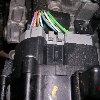rasouth
Well-Known Member
- Joined
- July 29, 2015
- Messages
- 345
- Reaction score
- 49
- City, State
- Riverside, CA
- Year, Model & Trim Level
- 96 Explorer XLT 4.0 OHV
This is kind of a follow up to my recent post "Dreaded cylinder misfire". It all started some months ago when I had the code PO302 pop up. I did the usual checking of wires, plugs, broken vacuum lines, etc... A few weeks later PO306 pops up... Checked wires, coil connection, pulled spark plugs on cylinder 5 and 6 to compare. Again, a few weeks later PO300... Multiple random misfires... Skip forward a week and I noticed water dripping out of tail pipe. Checked level in radiator, full to the top. No codes popped up ( I cleared the other codes). I then then replaced all plugs (wires were fairly new). That's when I posted "Dreaded misfire". I still drove the truck now and again and that's when I noticed overflow tank was empty and radiator coolant was down a couple of inches. All of which would point to a blown head gasket or a cracked head. (No water in oil, though)
My question now is... What are the chances that I would get a cracked head or broken gasket on both heads at the same time? Seeing as the error codes indicated number 2 and number 6, which are not on the same head. The car starts fine, idles good and drives fine with a little stutter now and again.
I did another rookie mistake. I did not do a compression check before I started tearing apart the top of the motor.
My question now is... What are the chances that I would get a cracked head or broken gasket on both heads at the same time? Seeing as the error codes indicated number 2 and number 6, which are not on the same head. The car starts fine, idles good and drives fine with a little stutter now and again.
I did another rookie mistake. I did not do a compression check before I started tearing apart the top of the motor.










